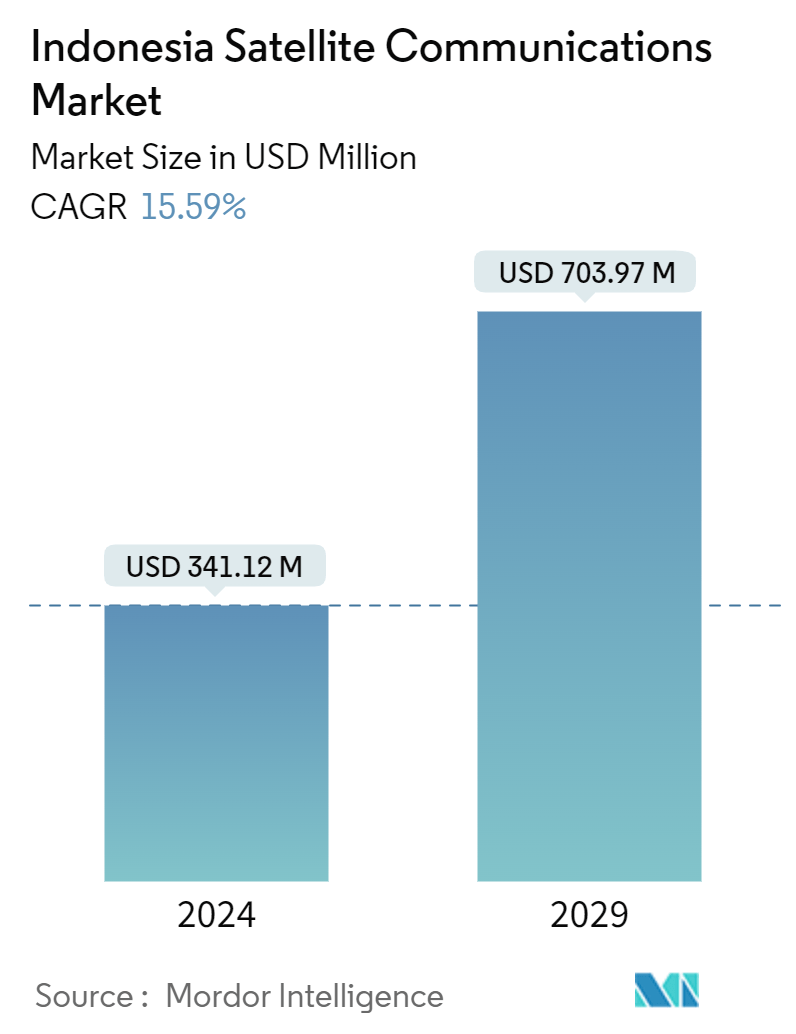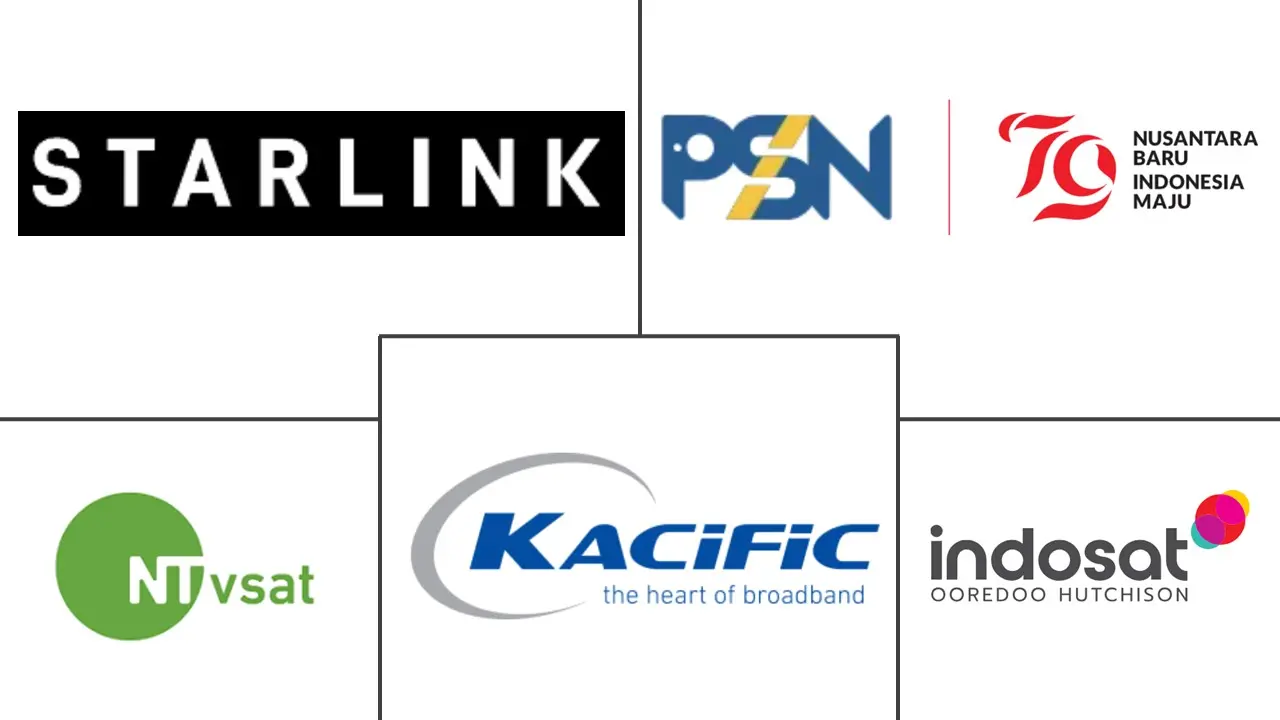Market Size of Indonesia Satellite Communications Industry

| Study Period | 2019 - 2029 |
| Base Year For Estimation | 2023 |
| Market Size (2024) | USD 341.12 Million |
| Market Size (2029) | USD 703.97 Million |
| CAGR (2024 - 2029) | 15.59 % |
| Market Concentration | Low |
Major Players
*Disclaimer: Major Players sorted in no particular order |
Indonesia Satellite Communications Market Analysis
The Indonesia Satellite Communications Market size is estimated at USD 341.12 million in 2024, and is expected to reach USD 703.97 million by 2029, growing at a CAGR of 15.59% during the forecast period (2024-2029).
Satellite communication is used for various applications across industries, such as media broadcasting, an extension of broadband coverage, 5G communications systems, integration and convergence of diverse wired and wireless technologies, earth observation, defense and security, and surveillance applications.
- To fulfil the operations, the solutions leveraging terrestrial mobile communication infrastructures, typically like long-term evolution (LTE), are relatively slow, expensive, and not easily scalable. Satellite communication is an efficient alternative because of its superior reliability, cost-effectiveness, excellent accessibility, and scalability, thereby providing plenty of opportunities for the growth of the market being studied.
- As the Government of the Republic of Indonesia diligently pursues the ambitious goal of Indonesia Emas 2045 (Golden Indonesia 2045), the nation's satellite development is entering a critical phase. The SATRIA-1 Satellite has significantly progressed, ensuring seamless telecommunications access to even Indonesia's most remote regions (3T). This achievement has revolutionized connectivity, enhancing internet access and communication in distant areas. These advancements have benefited sectors such as education, health, and the economy, laying a strong foundation for further leveraging satellite technology to drive economic growth and improve societal welfare.
- The expansion of 5G satellite communication is significantly driving the market's growth. This development is pivotal in addressing the connectivity challenges in the archipelagic nation, where terrestrial infrastructure often falls short. With 5G technology, satellite communication offers high-speed internet access even in remote and underserved areas, facilitating better integration into the digital economy and enhancing the quality of life for many Indonesians.
- Moreover, the Indonesian government has taken a proactive stance on digital inclusion and connectivity. Recognizing the strategic importance of satellite communications, the government has launched initiatives like the Palapa Ring project. This project aims to extend high-speed internet access to remote and underserved areas, often utilizing satellite technology to complement terrestrial networks. Such governmental initiatives significantly boost the demand for satellite communication services.
- The satellite industry is rapidly expanding, leading to high demand for STEM skills and difficulties for companies in recruitment. Efforts to tackle this issue are impeded by a lack of information, limited chances to enhance crucial abilities, and a deficiency of effective methods in hiring, education, and diversity.
Indonesia Satellite Communications Industry Segmentation
The utilization of artificial satellites in telecommunications for connecting different locations on Earth is known as satellite communication. Satellite communications are essential in the worldwide telecommunications network.
Indonesia's satellite communication (SATCOM) market study tracks the overall revenue accrued through the sale of ground equipment along with satellite-based voice and data services by market vendors in Indonesia. Satellite communication is the transfer of data and information via satellites orbiting the Earth; it enables long-distance communication by relaying signals between ground stations and satellite receivers in orbit, enabling television broadcasts, internet access, and phone calls. Moreover, satellite ground equipment comprises a complex array of interconnected systems, components, and infrastructure that work together to support satellite operations, communication, and data processing.
The Indonesia satellite communications market is segmented by offering (ground equipment, services), platform (portable, land, maritime, airborne), end-user vertical (maritime, defense and government, enterprises, media and entertainment, other end-user verticals). The market sizes and forecasts are provided in terms of value in (USD) for all the above segments.
| By Offering | |
| Ground Equipment | |
| Services |
| By Platform | |
| Portable | |
| Land | |
| Maritime | |
| Airborne |
| By End-user Vertical | |
| Maritime | |
| Defense and Government | |
| Enterprises | |
| Media and Entertainment | |
| Other End-user Verticals |
Indonesia Satellite Communications Market Size Summary
The Indonesian satellite communications market is a vital segment of the country's telecommunications infrastructure, addressing the unique challenges posed by its archipelagic geography. With over 17,000 islands, traditional terrestrial networks are inadequate for ensuring comprehensive national connectivity, making satellite communication an essential solution. The market is bolstered by significant investments from both the government and private sectors, focusing on telecommunication, broadcasting, and internet services. Notable developments include the launch of SpaceX's Starlink services, which aim to enhance internet access in remote areas, and the involvement of major players like PT Telekomunikasi Indonesia and international providers such as SES and Intelsat. These efforts are supported by government initiatives and regulatory frameworks that promote the deployment of satellite technology as part of Indonesia's digital economy strategy.
The market is experiencing growth driven by advancements in satellite technology, including high-throughput and low earth orbit satellites, which promise improved capacity and reduced latency. The expansion of 5G satellite communication is particularly significant, offering high-speed internet access to remote regions and facilitating better integration into the digital economy. Strategic partnerships and investments in 5G infrastructure are enhancing connectivity and supporting sectors like transportation and logistics. Government-backed projects, such as the SATRIA-1 satellite, underscore the commitment to leveraging satellite communication for national development. The market's evolution is characterized by a shift towards advanced technologies, with LEO satellites playing a crucial role in improving service quality and expanding the reach of digital services across Indonesia's diverse and challenging terrains.
Indonesia Satellite Communications Market Size - Table of Contents
-
1. MARKET INSIGHTS
-
1.1 Market Overview
-
1.2 Industry Stakeholder Analysis
-
1.3 Impact of Macroeconomic Trends
-
-
2. MARKET SEGMENTATION
-
2.1 By Offering
-
2.1.1 Ground Equipment
-
2.1.2 Services
-
-
2.2 By Platform
-
2.2.1 Portable
-
2.2.2 Land
-
2.2.3 Maritime
-
2.2.4 Airborne
-
-
2.3 By End-user Vertical
-
2.3.1 Maritime
-
2.3.2 Defense and Government
-
2.3.3 Enterprises
-
2.3.4 Media and Entertainment
-
2.3.5 Other End-user Verticals
-
-
Indonesia Satellite Communications Market Size FAQs
How big is the Indonesia Satellite Communications Market?
The Indonesia Satellite Communications Market size is expected to reach USD 341.12 million in 2024 and grow at a CAGR of 15.59% to reach USD 703.97 million by 2029.
What is the current Indonesia Satellite Communications Market size?
In 2024, the Indonesia Satellite Communications Market size is expected to reach USD 341.12 million.

